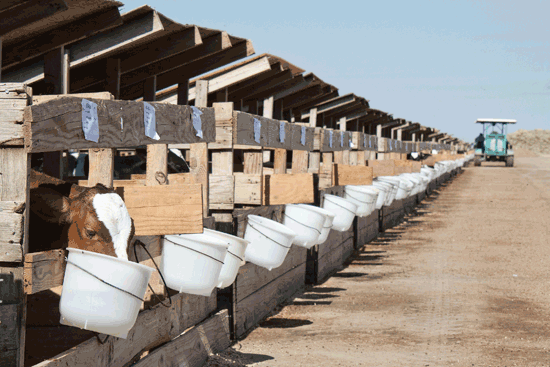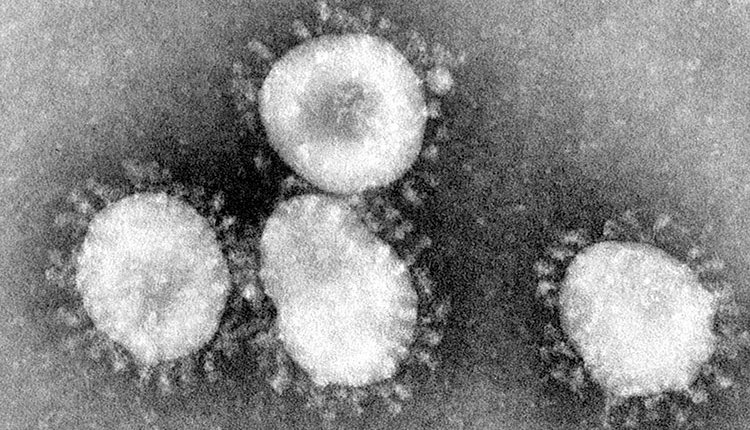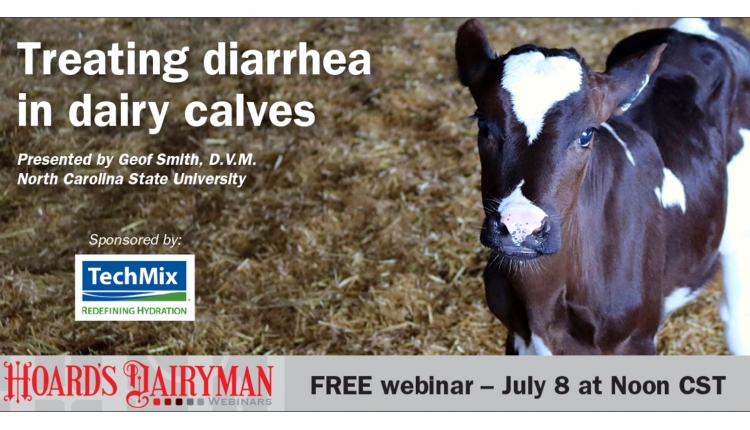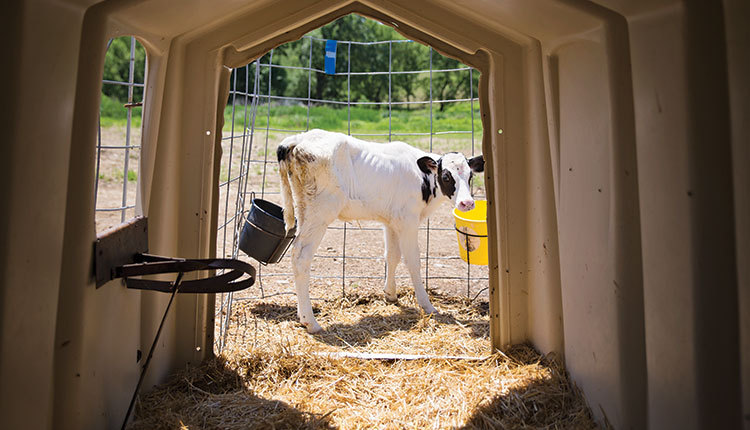The author is at the College of Veterinary Medicine, North Carolina State University, Raleigh.

Offering water to calves can help control bloat, as well as help growth rates. Be as consistent as possible in your milk or replacer feeding.
We are seeing more cases of bloat in dairy calves. This is completely different than the typical bloat you may be accustomed to with cows.
When cows bloat, free gas becomes trapped in the rumen (the first of four compartments), and they become distended on the left side. Bloat in young calves is caused by excessive gas in the abomasum (the last of the four compartments).
Affected calves typically are 5 to 10 days old (although it may occur up to 21 days of age) and usually do not have diarrhea. Clinical signs include refusal to drink milk, distension of the abdomen (bloat) on either the right side or both sides, and often death. This syndrome appears to occur sporadically, with some farms having several outbreaks.
Although we are not completely sure what causes bloat to occur, the disease appears to be related to several things. First, you need gas-producing bacteria in the abomasum. These include organisms such as Clostridium perfringens, Sarcina ventriculi, or Lactobacillus species that all have been suggested to play a role. However, many of these bacteria are present in the calf's stomach all the time, so other factors also must be involved.
Recently, the abomasal bloat syndrome was reproduced experimentally by drenching young Holstein calves with a carbohydrate mixture containing milk replacer, corn starch, and glucose mixed in water. The authors of that study suggested that abomasal bloat is caused primarily by the excess fermentation of high-energy, gastrointestinal contents. Thus, to cause abomasal bloat, we need to have large amounts of fermentable carbohydrate present in the abomasum (from milk, milk replacer, or high-energy oral electrolyte solutions) along with fermentative enzymes (produced by bacteria).
This process is exacerbated by anything that slows down the abomasal emptying rate. In fact, feeding high-osmolality electrolyte products, milk replacers, or both has been noted to be a primary risk factor on some farms.
This is not to say that accelerated feeding programs should be avoided. In fact, they have been shown to improve the growth rate of calves significantly. However, we need to pay close attention when mixing up milk replacers to make sure they contain the proper amount of water. The term "osmolality" is a measure of the concentration of particles in solution.
Cows' milk normally has an osmolality between 280 and 290 mOsm/L (milliosmoles per liter). This is called "isotonic" because this is equal to the osmolality of blood. However, some milk replacers and oral electrolyte products can be very hypertonic when mixed. This means they are much more concentrated than blood.
Recent research has shown that calves fed an oral electrolyte solution with high osmolality have a much slower abomasal emptying rate. This suggests that milk replacers or electrolytes with a very high osmolality will delay gastric emptying. They will allow bacteria already present in the stomach additional time for fermentation of carbohydrates. This often is what leads to excessive gas production and bloat.
As a goal, we should try to avoid feeding either milk replacers or oral electrolyte products that have an osmolality greater than 600 (mOsm/L) as the risk of bloat is likely to increase. I have measured the osmolality of milk replacers on more than 20 dairies with bloat problems and have found values well above 1,000 mOsm/L. However, I have not found any milk replacer whose osmolality would be greater than 600 when mixed according to label directions.
Therefore, mixing errors are largely responsible for very high values. These errors might be unintentional or can be done on purpose, such as concentrating powder to improve growth rates, for additional energy during cold weather, or adding electrolyte salts to milk without adding additional water.
Other risk factors for abomasal bloat include feeding a large volume of milk in a single daily feeding, cold milk (or milk replacer), not offering water to calves, erratic feeding schedules, and failure of passive transfer. Therefore, for farms that are having problems with bloat in young calves, I recommend you look at your calf feeding program. Make sure you are mixing up the milk replacer correctly and feeding it at a proper temperature.
It also is important to establish a consistent feeding schedule. If you're feeding twice a day, it doesn't have to be at exactly 12-hour intervals. You may choose to feed at 8 in the morning and then again at 4:30 in the afternoon. However, it is important to be consistent. Feeding calves "sometime during the morning" and then again "sometime during the evening" will add to your risk of bloat. If you have a bloated calf, it is important to call your veterinarian. These calves often will die fairly quickly, so rapid evaluation and treatment is important.
Don't tube them
Many people will attempt to pass a stomach tube to remove the gas from the stomach, similar to what is done to relieve bloat in cows. It is important to realize that this is not effective in calves. Since the gas is trapped in the abomasum, passing a tube into the rumen will not be effective in evacuating the gas, since it is impossible to pass a tube through the mouth and into the abomasum.
Also, sticking a needle in the stomach with the calf standing is not a good idea. This does not fully evacuate the gas in the abomasum, and you also run a significant risk of stomach fluid leaking into the abdomen. This can result in other serious complications. Therefore, it is important to work with your veterinarian to develop protocols and how to treat cases of bloat when they happen on your farm.
Although there is very little published science in this area, giving a scours vaccine to your dry cows is another thing that might help prevent bloat in young calves. There are several of these products on the market such as ScourGuard from Pfizer, Scour Bos 9 from Novartis, or Schering-Plough's Guardian vaccine. All of these products contain a toxoid against clostridium perfringens and are designed to be given to the pregnant cow prior to calving. They will boost colostral antibody levels to the primary diseases that cause diarrhea in calves and also may help provide some immunity against clostridial organisms which can frequently be associated with bloat.
Colostral antibodies also are absorbed into the blood at birth and circulate for several weeks. From the bloodstream, these antibodies can be resecreted back across the surface of the gut for an extended period of time to help prevent diarrhea. Although there has not been specific research to demonstrate that the use of these vaccines protects against bloat in young calves, my experience suggests they can be very helpful.
In summary, the most important control factors are to establish a consistent feeding program with milk or milk replacer that has been mixed according to the label directions. Also, work with your veterinarian to establish treatment programs so cases can be managed quickly and effectively.
Click here to return to the Animal Care E-Sources
100410_252

We are seeing more cases of bloat in dairy calves. This is completely different than the typical bloat you may be accustomed to with cows.
When cows bloat, free gas becomes trapped in the rumen (the first of four compartments), and they become distended on the left side. Bloat in young calves is caused by excessive gas in the abomasum (the last of the four compartments).
Affected calves typically are 5 to 10 days old (although it may occur up to 21 days of age) and usually do not have diarrhea. Clinical signs include refusal to drink milk, distension of the abdomen (bloat) on either the right side or both sides, and often death. This syndrome appears to occur sporadically, with some farms having several outbreaks.
Although we are not completely sure what causes bloat to occur, the disease appears to be related to several things. First, you need gas-producing bacteria in the abomasum. These include organisms such as Clostridium perfringens, Sarcina ventriculi, or Lactobacillus species that all have been suggested to play a role. However, many of these bacteria are present in the calf's stomach all the time, so other factors also must be involved.
Recently, the abomasal bloat syndrome was reproduced experimentally by drenching young Holstein calves with a carbohydrate mixture containing milk replacer, corn starch, and glucose mixed in water. The authors of that study suggested that abomasal bloat is caused primarily by the excess fermentation of high-energy, gastrointestinal contents. Thus, to cause abomasal bloat, we need to have large amounts of fermentable carbohydrate present in the abomasum (from milk, milk replacer, or high-energy oral electrolyte solutions) along with fermentative enzymes (produced by bacteria).
This process is exacerbated by anything that slows down the abomasal emptying rate. In fact, feeding high-osmolality electrolyte products, milk replacers, or both has been noted to be a primary risk factor on some farms.
This is not to say that accelerated feeding programs should be avoided. In fact, they have been shown to improve the growth rate of calves significantly. However, we need to pay close attention when mixing up milk replacers to make sure they contain the proper amount of water. The term "osmolality" is a measure of the concentration of particles in solution.
Cows' milk normally has an osmolality between 280 and 290 mOsm/L (milliosmoles per liter). This is called "isotonic" because this is equal to the osmolality of blood. However, some milk replacers and oral electrolyte products can be very hypertonic when mixed. This means they are much more concentrated than blood.
Recent research has shown that calves fed an oral electrolyte solution with high osmolality have a much slower abomasal emptying rate. This suggests that milk replacers or electrolytes with a very high osmolality will delay gastric emptying. They will allow bacteria already present in the stomach additional time for fermentation of carbohydrates. This often is what leads to excessive gas production and bloat.
As a goal, we should try to avoid feeding either milk replacers or oral electrolyte products that have an osmolality greater than 600 (mOsm/L) as the risk of bloat is likely to increase. I have measured the osmolality of milk replacers on more than 20 dairies with bloat problems and have found values well above 1,000 mOsm/L. However, I have not found any milk replacer whose osmolality would be greater than 600 when mixed according to label directions.
Therefore, mixing errors are largely responsible for very high values. These errors might be unintentional or can be done on purpose, such as concentrating powder to improve growth rates, for additional energy during cold weather, or adding electrolyte salts to milk without adding additional water.
Other risk factors for abomasal bloat include feeding a large volume of milk in a single daily feeding, cold milk (or milk replacer), not offering water to calves, erratic feeding schedules, and failure of passive transfer. Therefore, for farms that are having problems with bloat in young calves, I recommend you look at your calf feeding program. Make sure you are mixing up the milk replacer correctly and feeding it at a proper temperature.
It also is important to establish a consistent feeding schedule. If you're feeding twice a day, it doesn't have to be at exactly 12-hour intervals. You may choose to feed at 8 in the morning and then again at 4:30 in the afternoon. However, it is important to be consistent. Feeding calves "sometime during the morning" and then again "sometime during the evening" will add to your risk of bloat. If you have a bloated calf, it is important to call your veterinarian. These calves often will die fairly quickly, so rapid evaluation and treatment is important.
Don't tube them
Many people will attempt to pass a stomach tube to remove the gas from the stomach, similar to what is done to relieve bloat in cows. It is important to realize that this is not effective in calves. Since the gas is trapped in the abomasum, passing a tube into the rumen will not be effective in evacuating the gas, since it is impossible to pass a tube through the mouth and into the abomasum.
Also, sticking a needle in the stomach with the calf standing is not a good idea. This does not fully evacuate the gas in the abomasum, and you also run a significant risk of stomach fluid leaking into the abdomen. This can result in other serious complications. Therefore, it is important to work with your veterinarian to develop protocols and how to treat cases of bloat when they happen on your farm.
Although there is very little published science in this area, giving a scours vaccine to your dry cows is another thing that might help prevent bloat in young calves. There are several of these products on the market such as ScourGuard from Pfizer, Scour Bos 9 from Novartis, or Schering-Plough's Guardian vaccine. All of these products contain a toxoid against clostridium perfringens and are designed to be given to the pregnant cow prior to calving. They will boost colostral antibody levels to the primary diseases that cause diarrhea in calves and also may help provide some immunity against clostridial organisms which can frequently be associated with bloat.
Colostral antibodies also are absorbed into the blood at birth and circulate for several weeks. From the bloodstream, these antibodies can be resecreted back across the surface of the gut for an extended period of time to help prevent diarrhea. Although there has not been specific research to demonstrate that the use of these vaccines protects against bloat in young calves, my experience suggests they can be very helpful.
In summary, the most important control factors are to establish a consistent feeding program with milk or milk replacer that has been mixed according to the label directions. Also, work with your veterinarian to establish treatment programs so cases can be managed quickly and effectively.
100410_252











